牛津译林版8A Unit5 Reading1 教案
- 格式:doc
- 大小:25.00 KB
- 文档页数:2
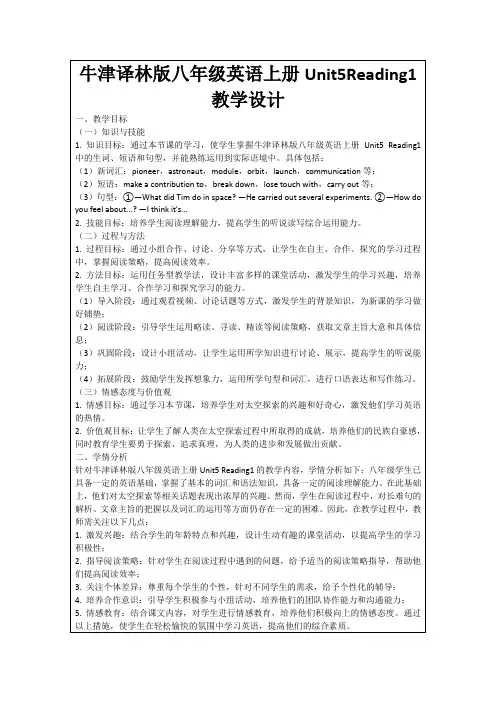
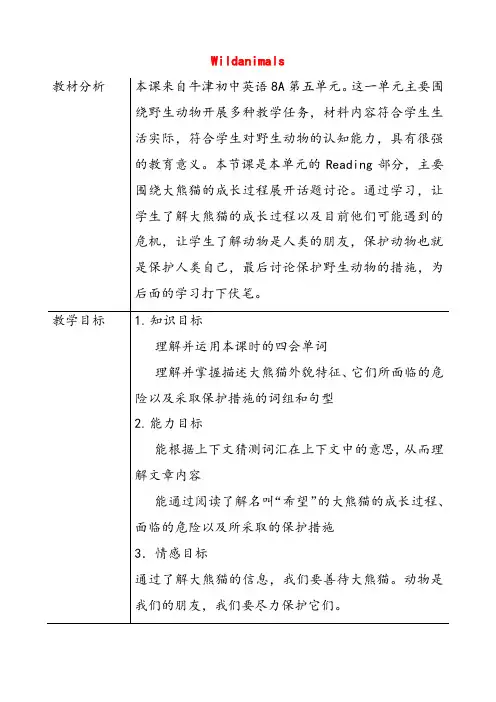
Wildanimals教学重难点理解文章大意,掌握语言授课类型新授讲授方法Task-basedteachingmethord教具准备PPT学生提前互动准备动物特征纸条、学生对人类要说的话奖励物品(小熊猫)教学过程及时间主要教学内容教学方法应用PartOnePre-reading 1.Aguessing game2.Presentne wwordsPartTwo While-readi Goodmorning,boysandgirls.Nicetomeetyou.Lastclasswehavelearntmanynamesofanimals.Doyourememberthem?Good.Let’splayaguessinggame,ok? Iwillaskonestudenttosaysthabouthisfa vouriteanimal.Theotherspleaseguesswhatitis.(Good.Let’sclapourhandsforthem) (Congratulationstoyou)Youareveryclever.Doyouwanttoknowmyfa vouriteanimal?Myfavouriteanimalisverylovely.Itisbl学生回答Yes请四位学生描述他最喜欢的动物的特征,其他人猜动物名称。
学生回答Yes请一位学ng1.Presentth ephotosofJa ckyChen2TaskOne Listenandfi ndthemainid ea:3TaskTwo Line1-14The growthofXiW ang4.TaskThree Line15-22Th eproblemsgi antpandasma ymeet5.TaskFour Line23-30Th ackandwhite.ItusuallylivesinChina.It sfavouritefoodisbambooshootsand leaves.Whatisit?(congratulations)(跟学生握手以示祝贺)(显示大熊猫图片)Look.Whatarethey?Look.Itisababypanda.(显示熊猫宝宝图片)Whatdogiantpandaslikeeating?(引出竹子图片)Lookatthepicture.Theyarebamboos.They arebambooleaves.Bambooshoots.Bambooforest.Lookatthispicture.Whoishe?Look.Heiswithapanda.Heistheambassado roflovingpandas.Doyouthinkheisgreat? DoyouwanttobesuchamanlikeJackyChen?I fyouwant,youmustknowthegiantpandasverywell.So,let’slearnastoryofagiantp andacalledXiWang.Openyourbooksontopage60.Firstlet’sl生回答Giantpanda学生回答theyaregiantpandas学生跟读新单词3遍学生回答Jac kyChen学生听录音完成第一个任务学生自行阅读完成表格,请几位学生eactionswec antakePartThreeAf ter-reading 1.Discussi on2.Watchavi deoPartFourHom ework istentothetapewithyourbook.Trytoputt hestoryintothreeparts.Youdidagoodjob. Ifyouwanttobeanambassadoroflovingpandas,youmustknowthegrowthofpandas. SopleasereadPart1byyourselvesandtryt ofinishthetable. NowIthinkyoucanfinishPartCinyourbookeasily.Aregiantpandaslovely? Buttheyhaveproblemsnow.Let’slearnPa rtTwoandseewhatproblemstheyhave. Closeyourbooksandlisten.Trytofillint heblanks.Yes.Thesearetheproblems.Doyouknowany otherproblemsforgiantpandas。
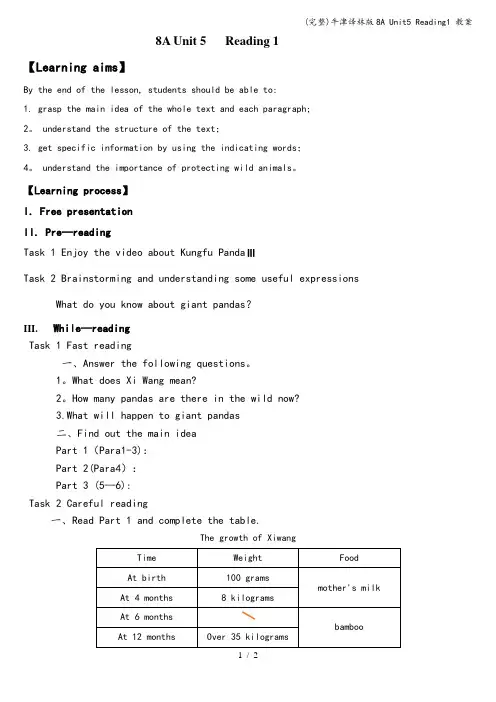
8A Unit 5 Reading 1【Learning aims】By the end of the lesson, students should be able to:1. grasp the main idea of the whole text and each paragraph;2。
understand the structure of the text;3. get specific information by using the indicating words;4。
understand the importance of protecting wild animals。
【Learning process】I. Free presentationII. Pre—readingTask 1 Enjoy the video about Kungfu PandaⅢTask 2 Brainstorming and understanding some useful expressions What do you know about giant pandas?III.While—readingTask 1 Fast reading一、Answer the following questions。
1。
What does Xi Wang mean?2。
How many pandas are there in the wild now?3.What will happen to giant pandas二、Find out the main ideaPart 1(Para1-3):Part 2(Para4):Part 3 (5—6):Task 2 Careful reading一、Read Part 1 and complete the table.The growth of Xiwang二、Suppose you are Xi Wang and say something about yourself三、Read Part 2 and complete the short passage四、Read Part 3 and answer the following questionWhat can we do to save giant pandas?IV。
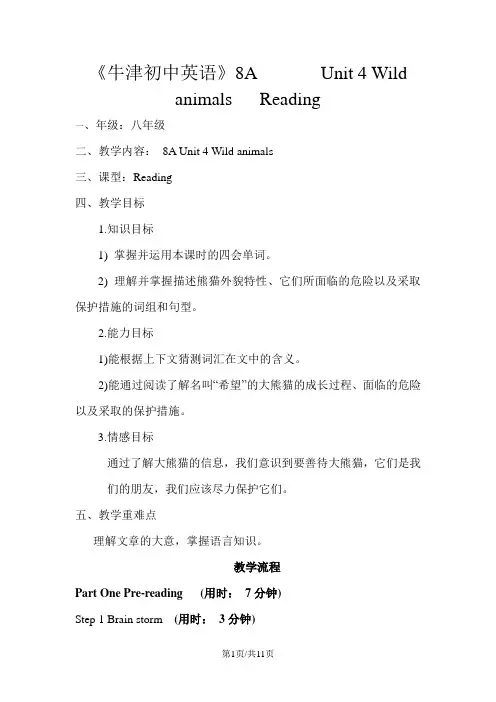
《牛津初中英语》8A Unit 4 Wildanimals Reading一、年级:八年级二、教学内容:8A Unit 4 Wild animals三、课型:Reading四、教学目标1.知识目标1) 掌握并运用本课时的四会单词。
2) 理解并掌握描述熊猫外貌特性、它们所面临的危险以及采取保护措施的词组和句型。
2.能力目标1)能根据上下文猜测词汇在文中的含义。
2)能通过阅读了解名叫“希望”的大熊猫的成长过程、面临的危险以及采取的保护措施。
3.情感目标通过了解大熊猫的信息,我们意识到要善待大熊猫,它们是我们的朋友,我们应该尽力保护它们。
五、教学重难点理解文章的大意,掌握语言知识。
教学流程Part One Pre-reading (用时:7分钟)Step 1 Brain storm (用时:3分钟)Today we are going to learn Unit 4 Wild animals Reading. 同学们,今天我们将学习第一单元的阅读课。
We learned many wild animals, such as tigers, bears, kangaroos…我们已经学会了一些关于野生动物的内容。
First, let’s paly a game called ‘Brainstorm’.I’ll describe one kind of animals, please tell me what it is at once. 我来描述一种动物,请立刻告诉我它的名称。
It is a sea animal and looks like a large fish. It is very clever and often plays some games for us in the zoo.Yes, it’s a dolphin.It’s a heavy wild anima l with thick fur and sharp paws. It can walk upright.Yes, it’s a bear.It’s the king of the animal w orld. It has yellow fur and black stripes on its body.Yes, it’s a tiger.It jumps with its baby in its pocket. You can see it in Australia. Yes, it’s a kangaroo.It lives in China. It is black and white. Its favorite food is bamboo shoots and leaves.Yes, it’s a giant panda.Step 2 Practice (用时:4分钟)Now, let’s have a discussion.Which aniaml do you like best? Why?Which animal do you like least? Why?Part Two While-reading (用时:20分钟)Step 1 Presentation (用时:1分钟)I like giant pandas best. Because I think they are beautiful black and white animals. They are very lovely, quiet and peaceful. 我最喜欢大熊猫。
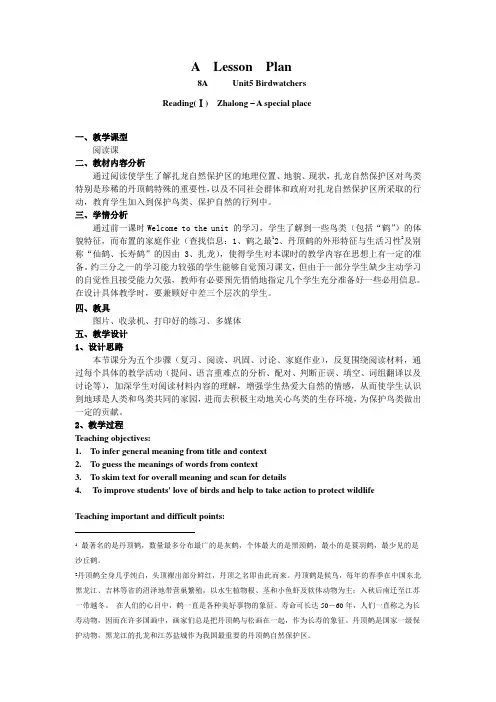
A Lesson Plan8A Unit5 BirdwatchersReading(Ⅰ) Zhalong – A special place一、教学课型阅读课二、教材内容分析通过阅读使学生了解扎龙自然保护区的地理位置、地貌、现状,扎龙自然保护区对鸟类特别是珍稀的丹顶鹤特殊的重要性,以及不同社会群体和政府对扎龙自然保护区所采取的行动,教育学生加入到保护鸟类、保护自然的行列中。
三、学情分析通过前一课时Welcome to the unit 的学习,学生了解到一些鸟类(包括“鹤”)的体貌特征,而布置的家庭作业(查找信息:1、鹤之最12、丹顶鹤的外形特征与生活习性2及别称“仙鹤、长寿鹤”的因由3、扎龙),使得学生对本课时的教学内容在思想上有一定的准备。
约三分之一的学习能力较强的学生能够自觉预习课文,但由于一部分学生缺少主动学习的自觉性且接受能力欠强,教师有必要预先悄悄地指定几个学生充分准备好一些必用信息。
在设计具体教学时,要兼顾好中差三个层次的学生。
四、教具图片、收录机、打印好的练习、多媒体五、教学设计1、设计思路本节课分为五个步骤(复习、阅读、巩固、讨论、家庭作业),反复围绕阅读材料,通过每个具体的教学活动(提问、语言重难点的分析、配对、判断正误、填空、词组翻译以及讨论等),加深学生对阅读材料内容的理解,增强学生热爱大自然的情感,从而使学生认识到地球是人类和鸟类共同的家园,进而去积极主动地关心鸟类的生存环境,为保护鸟类做出一定的贡献。
2、教学过程Teaching objectives:1. To infer general meaning from title and context2. To guess the meanings of words from context3. To skim text for overall meaning and scan for details4. To improve students' love of birds and help to take action to protect wildlifeTeaching important and difficult points:1最著名的是丹顶鹤,数量最多分布最广的是灰鹤,个体最大的是黑颈鹤,最小的是蓑羽鹤,最少见的是沙丘鹤。
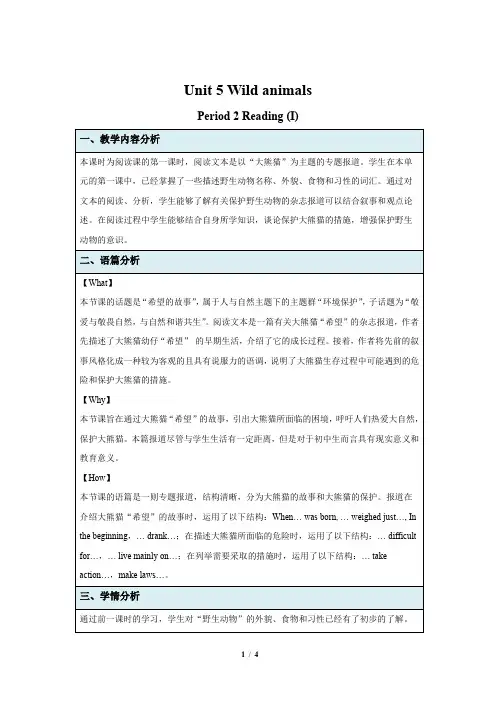
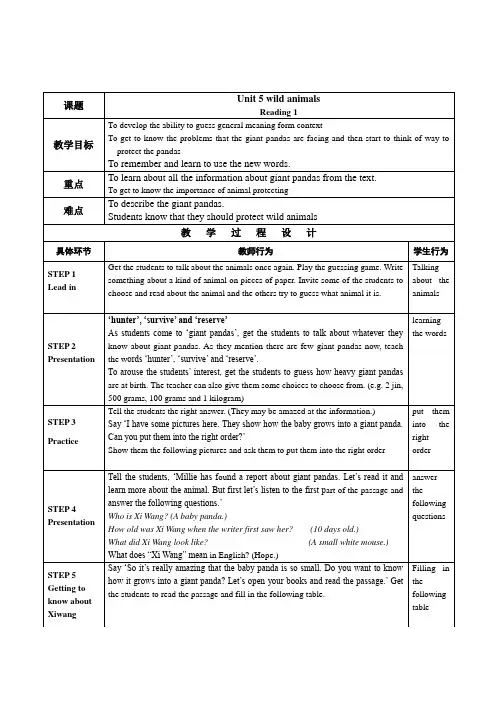
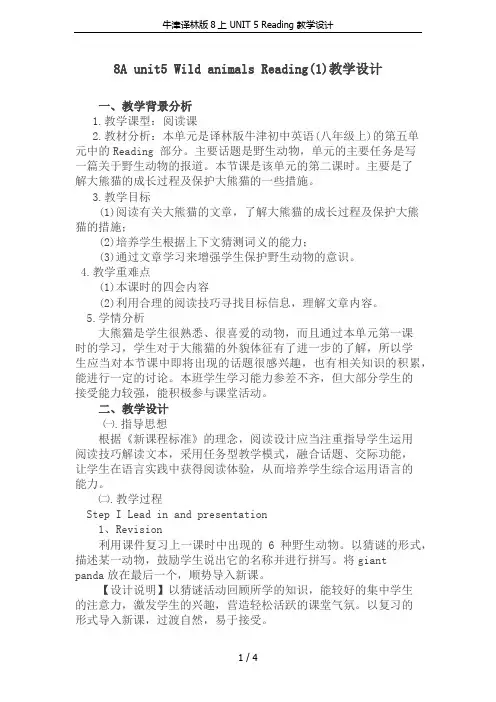
8A unit5 Wild animals Reading(1)教学设计一、教学背景分析1.教学课型:阅读课2.教材分析:本单元是译林版牛津初中英语(八年级上)的第五单元中的Reading 部分。
主要话题是野生动物,单元的主要任务是写一篇关于野生动物的报道。
本节课是该单元的第二课时。
主要是了解大熊猫的成长过程及保护大熊猫的一些措施。
3.教学目标(1)阅读有关大熊猫的文章,了解大熊猫的成长过程及保护大熊猫的措施;(2)培养学生根据上下文猜测词义的能力;(3)通过文章学习来增强学生保护野生动物的意识。
4.教学重难点(1)本课时的四会内容(2)利用合理的阅读技巧寻找目标信息,理解文章内容。
5.学情分析大熊猫是学生很熟悉、很喜爱的动物,而且通过本单元第一课时的学习,学生对于大熊猫的外貌体征有了进一步的了解,所以学生应当对本节课中即将出现的话题很感兴趣,也有相关知识的积累,能进行一定的讨论。
本班学生学习能力参差不齐,但大部分学生的接受能力较强,能积极参与课堂活动。
二、教学设计㈠.指导思想根据《新课程标准》的理念,阅读设计应当注重指导学生运用阅读技巧解读文本,采用任务型教学模式,融合话题、交际功能,让学生在语言实践中获得阅读体验,从而培养学生综合运用语言的能力。
㈡.教学过程Step I Lead in and presentation1、Revision利用课件复习上一课时中出现的6种野生动物。
以猜谜的形式,描述某一动物,鼓励学生说出它的名称并进行拼写。
将giantpanda放在最后一个,顺势导入新课。
【设计说明】以猜谜活动回顾所学的知识,能较好的集中学生的注意力,激发学生的兴趣,营造轻松活跃的课堂气氛。
以复习的形式导入新课,过渡自然,易于接受。
2、Brainstorming(1)展示大熊猫的图片,教师提问:Can you say something about it? 鼓励学生对它进行描述和介绍,可提示学生可以从他们的外貌,饮食等来描述。
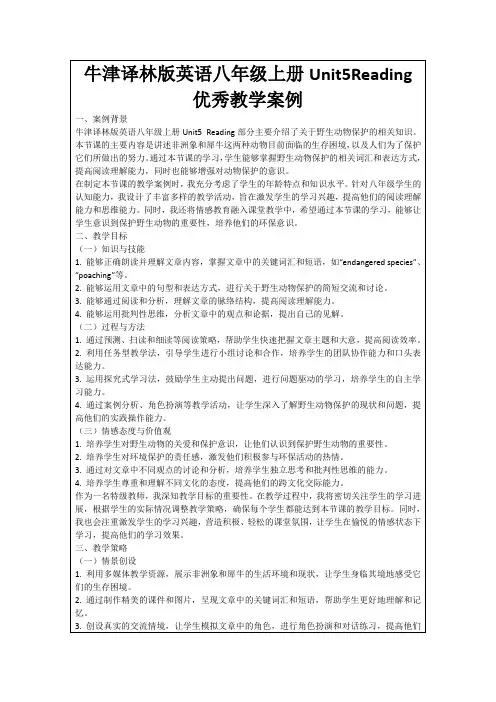
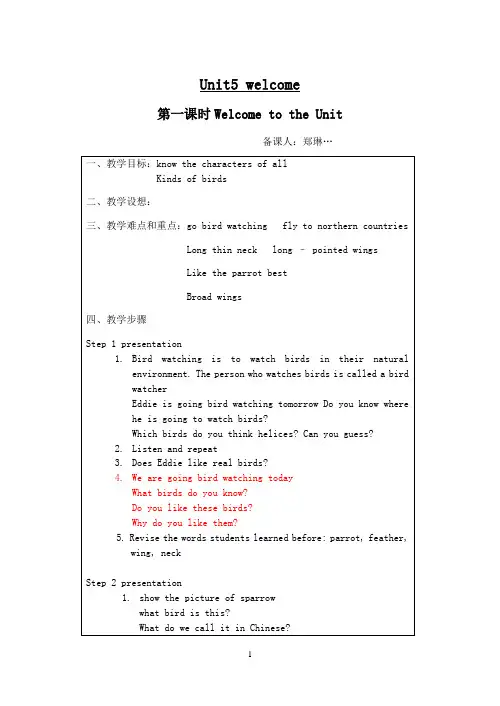
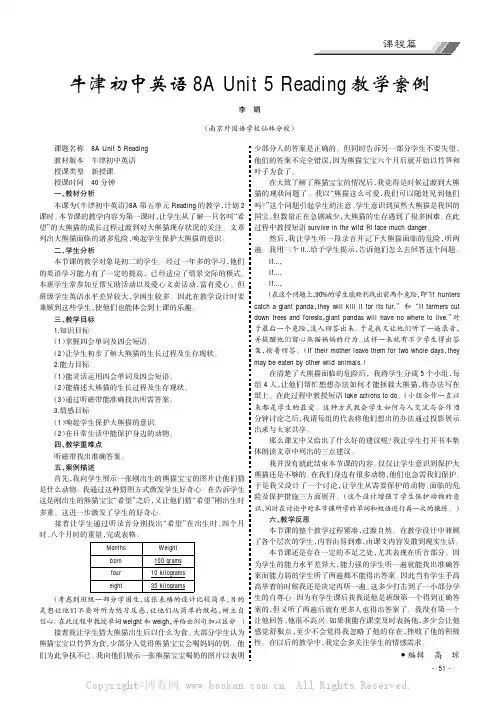
课程篇课题名称8A Unit5Reading教材版本牛津初中英语授课类型新授课授课时间40分钟一、教材分析本课为《牛津初中英语》8A第五单元Reading的教学,计划2课时。
本节课的教学内容为第一课时,让学生从了解一只名叫“希望”的大熊猫的成长过程过渡到对大熊猫现存状况的关注。
文章列出大熊猫面临的诸多危险,唤起学生保护大熊猫的意识。
二、学生分析本节课的教学对象是初二的学生。
经过一年多的学习,他们的英语学习能力有了一定的提高,已经适应了情景交际的模式。
本班学生常参加互帮互助活动以及爱心义卖活动,富有爱心。
但班级学生英语水平差异较大,学困生较多。
因此在教学设计时要兼顾到这些学生,使他们也能体会到上课的乐趣。
三、教学目标1.知识目标(1)掌握四会单词及四会短语。
(2)让学生初步了解大熊猫的生长过程及生存现状。
2.能力目标(1)能灵活运用四会单词及四会短语。
(2)能描述大熊猫的生长过程及生存现状。
(3)通过听磁带能准确找出所需答案。
3.情感目标(1)唤起学生保护大熊猫的意识。
(2)在日常生活中能保护身边的动物。
四、教学重难点听磁带找出准确答案。
五、案例描述首先,我向学生展示一张刚出生的熊猫宝宝的图片让他们猜是什么动物。
我通过这种猜图方式激发学生好奇心。
在告诉学生这是刚出生的熊猫宝宝“希望”之后,又让他们猜“希望”刚出生时多重。
这进一步激发了学生的好奇心。
接着让学生通过听录音分别找出“希望”在出生时、四个月时、八个月时的重量,完成表格。
Months Weightborn100gramsfour10kilogramseight35kilograms(考虑到班级一部分学困生,这张表格的设计比较简单,目的是想让他们不要对听力练习反感,让他们从简单的做起,树立自信心。
在此过程中教授单词weight和weigh,并给出例句加以区分。
)接着我让学生猜大熊猫出生后以什么为食。
大部分学生认为熊猫宝宝以竹笋为食,少部分人觉得熊猫宝宝会喝妈妈的奶。
Unit 5Wild Animals Reading教案(一)总课题8A Unit 5WildAnimals总课时第课时课题Reading 课型New教学目标知识目标1.Be able to understand and use the words andphrases to describe the giant pandas’ appearance andtake actions to protect them。
2.To to realize we must try our best to protect pandas.3.To know the growth of Xiwang and how to protectthem.能力目标Through the posts to enhance students' learning protectwildlife consciousness.情感目标Through the posts to enhance students' learning protectwildlife consciousness.教学重点1.To understand the main idea of the article.2.To learn how to take actions to protect the wild animals教学难点1.To understand the main idea of the article.2.To learn how to take actions to protect the wild animals课前预习1Preview the new words.2Listen to the tape and read the text教学过程教学环节教师活动二次备课Step 1. Warm up Step 2.Pre-readingStep3.While-reading 1.To check the preposition2.To talk about some wild animals.T: Can you tell me which is your favourite w ild animal?And can you tell me which is my favourite wild animal?T: Do you know why I like giant pandas best ? Because giant pandas are very lovely. They look like white mice when they were born. They look like bears when they grow up. They are friendly , too. They like eating bamboo leaves and shoots. They seldo m eat meat or hurt other animals. But it’s a pity that there are not many giant pandas in the world. They’re in danger. Hunters catch them and kill them for their fur . And farmers cut down trees and forests. So they have nowhere to live. We should take actions to protect them.(let Ss read the words after the teacher)T: Here is a story of Xi Wang, a very lovely giant panda. Would you like to read it with m e? Now open your books, turn to P.60. Read it quickly and answer the following questions .1) What’s the story about?2)What will happen to giant pandas if we do nothing?Step4Post-readingStep5 SummaryStep6. Homework T: Now , listen to the tape and read after it and then answer the six questions on the screen . Then encourage the students to find the main ideas about this story.T: Now Let’s find the main ideas together and put them on the blackboard.T: Look at the screen . Finish the table of “The growth o f Xi Wang”. Catch more details about XiWang.T: Now please read the passage together . Then finish the exercises on P. 61 Part B And Part C.T: Now , We’ve known the giant pandas very well , They are very lovely and we love them very much . But th ere are fewer and fewer pandas in the world . They’re in danger . Do you know why? Now,work in groups and find out “What problems can a giant panda meet in its life?”Then ask some able students of each group to talk in front of the class. After that,finish the Note-making 2 on the screen. T: Discuss with your partners: What other problems will the giant pandas have? What actions can we take ?And can you have a face to face interview about pandas?Teacher makes a summary that we should take actions to protect gian t pandas.1.Write an article about “what’s the relationship between wild animals and human beings?”2.Finish the exercises of reading教学反思总课题8A Unit 5Wild Animals 总课时第课时课题Reading 课型New教学目标知识目标1.Learing and using the language points2.To develop the Ss’ abilities of using English3.To train the Ss’ ability of learning by doing.能力目标To train the Ss’ ability of learning by doing.情感目标To learn how to take actions to protect the wild animals 教学重点Retell the reading and use the language points correctly.教学难点Retell the reading and use the language points correctly.课前预习Listen to the tape and read the text Revise the ways to give directions教学过程教学环节教师活动二次备课Step1 RevisionStep2 Language points 1 Say something about giant pand as2 Finish the table about the growth of Xiwang3 Review what danger giant pandas meet and what actions we can take4. Fill in blanks with proper forms.Explain the following language points to students1.be in danger.Many wild animals are in danger.2. She grew into a healthy young giant panda and weighed 35 kilograms. grow into意为“长成----”“发展成----”,其中grow作行为动词;weigh v.称重weighed weight n.重3.encourage sb to do sth.The English teacher always encourages me to speak more in class.4. following adj.We must take the following actions to learn English well.5. have nowhere to liveIf farmers cut down trees and forests, giant pandas will have nowhere to live.6.At the very beginning, XiWang drankhermother’s milk for up to 14 hours a day.at th e very beginning 在开始时At the very beginning, I didn’t like maths.Up to意为“高达,达到,一直到”。
八年级英语上册Unit5 Reading(1)教学设计(牛津译林版)8A Unit 5 Wild animals Period 2 Reading (1) 1. 95% students learn to get specific information by using the indicating words; 2. 90% students to understand the understand the importance of protecting wild animals. 閲嶉毦鐐?To let students know the background of different wild animals in the world and talk about them 鏃堕棿鏁欏笀娲诲姩瀛︾敓娲诲姩Step 2 Presentation Step 3 Consolidation Enjoy a video about Kungfu Panda II. T: Today, we 鈥檒l continue to learn about wild animals. First, let鈥檚enjoy a video. T: As we can see, the panda in the film is very good at kungfu and it lives happily. But it is very difficult for real pandas to survive in the wild. They need our help, right? In fact, there are a lot of things that we can do to care about the pandas. We can join the WWF. We can design a leaflet to ask people to help the pandas. So, let鈥檚think about how to design a leaflet. I am sure that you will know how to design it after learning this report on the baby panda Xi Wang.1. Learn the new expressions (1) B rainstorm T: What do you know about giant pandas? (2) Present the new expressions T: Most of you know that the giant pandas live mainly on bamboo. And you also know that the number of giant pandas is very small because they are facing serious problems. They are in danger. Shall we take action to protect them? (Show some pictures with the words: live mainly on, face serious problems, be in danger and take action right away.) T: In fact, there are a lot of facts about giant pandas that you don鈥檛know. In the article, The Story of Xi Wang, you find them and think you will know how to protect them after reading it.2. Skim for the main idea of the whole text (1) Watch a video of the text and skim for the main idea of the article T: First, let鈥檚watch a video to get a general idea of the text. T: Can you find an easy way to get the main idea of the article quickly?(Group work) T: Sometimes, we can get the main idea of the whole article from the title, the pictures and the first and last paragraph. (2) Have a try T: Let鈥檚have a challenge to get the main idea of the text. 3. Skim for the main idea of each paragraph (1) Brainstorm T: The report is about the pandas, so let鈥檚guess in what aspects we can introduce the pandas. We will use the mind map to help us. Here, I will give you a sample of the mind map. (2) Skim for the main ideas of paragraph 2 to 5 T: All of you have thought of so many ideas. Now, let鈥檚read paragraph 2-5 and find their main ideas to see whether you have made the right prediction. (3) Explain how to find out the main idea with the topic sentence. T: Here, I have a question for you. How did you find the main idea of paragraph 4? Can you circle the topic sentence? 4. Understand the structure of the text T: So far, we have known how the report is organized. It is time for us to analyze the structure of the report. How many parts can the report be divided into? What are they? Please work in groups. 5. Scanning for the specific information. (1) Finish the table. T: Boys and girls ,we have known the structure of this article and the main idea of each paragraph. Now, let鈥檚get a close look at the article. First, let鈥檚find out what the pandas eat and how much they weigh in different stages. You can circle some useful words while looking for answers. Now, please listen to the tape and then finish the table. Information about Xiwang Time Weight Food At birth 100 grams mother鈥檚milk At 4 months 8 kilograms At 6 months bamboo At 12 months Over 35 kilograms At 20 months look after herself (2) Discussion T: While looking for the answers, you may find some useful words that can help you quickly find the information you need. Can you circle them? (3) Scanning for the specific information T: Next, let鈥檚find out what problems the pandas face and what actions we can take. You can circle some useful words while looking for answers. (4) Have a try T: Let 鈥檚have a challenge to use the indicating words to find the answers. 6. Summary T: Now we have a better understanding of the text. Let鈥檚review what we learnt.1. Retell the text T: Boys and girls, so far, we have learnt a lot of details about giant pandas. I think we can tell our friends or someone else about this lovely wild animal. Let鈥檚retell the story. Here are some useful expressions for you. look like a white mouse weigh just 100 grams at four months old eightmonthslater not 鈥?any more in the beginning look after herself face serious problems it is difficult for 鈥?to鈥?live mainly on become smaller and smaller as a result be in danger take action 2. Finish a leaflet T: We need to take action to help them right now. Please design a leaflet to ask people to care about giant pandas. Here are some useful expressions. 鈥?be born in the beginning when 鈥?Sadly 鈥?for example 鈥?Also... in danger take action 3. Summary T: No buying, no killing! Homework 1. Search the internet to find out more ways to protect wild animals; 2. Finish the paper. 1.Enjoy a video about Kungfu Panda II.2.Learn the new expressions.3.Watch a video of the text and skim for the main idea of the article4.Skim for the main idea of each paragraph.5.Skim for the main idea of paragraphs2to5.6.Circle the topic sentence of paragraph4.7.Analyze the structure of the report.8.listen to the tape and then finish the table.9.Circle some useful words to tell us what problems the pandas face.10.Retell the text with the help of some useful expressions.11.Design a leaflet to ask people to care about giant pandas.犵殑鍏磋叮銆?岀壒寰佸拰鐢熸椿涔犳€э╃敤鍥?В璇炬枃澶ф?ぇ鎰忕殑鎶€宸э??熷湪浜嗚В鏂囩珷澶ф鑺備?╀簬浠栦滑瀵规枃绔犵殑杩涗竴姝ョ悊瑙c€?屼粠鑰屾洿濂藉湴浜嗚В鈥滃笇鏈涒€濇垚闀跨殑杩囩▼锛岃繘涓€姝ユ縺鍙?х煡璇嗙殑鏁村悎锛屽煿鍏诲?璇惧爞妫€娴?The baby panda called Xi Wang weighed just 100 grams at______and looked______a white mouse.At four months old,she began to go outside for the ______time.Eight months later,sheweighed______35kilograms. In the beginning, Xi Wang drank her mother鈥檚milk.When she was six months old,she began to eat______.When she was 20 months old,she learnt to look after______. Sadly,giant pandas face serious problems inthe________.For example,it is very difficult for pandas to have_______,and many baby pandas die when they are very young.Also,giant pandas live______on a special kind of bamboo.However,the bamboo_______are becoming smaller and smaller.As a result,pandas may not have a place to live or ______to eat. Giant pandas are now in_____.We should take action right away.We can help pandas have______babies,build more panda reserves or make ______to protect pandas.There are now only about 1,600 pandas in the wild.If we do nothing,______there may be none left! Keys:1.birth 2.like 3.first 4.over 5.bamboo 6.herself 7.wild 8.babies9.mainly 10.forests 11.food 12.danger 13.more ws 15.soon。
8A Unit 5 Reading 1 【Learning aims】
By the end of the lesson, students should be able to:
1. grasp the main idea of the whole text and each paragraph;
2. understand the structure of the text;
3. get specific information by using the indicating words;
4. understand the importance of protecting wild animals.
【Learning process】
I. Free presentation
II. Pre-reading
Task 1 Enjoy the video about Kungfu PandaⅢ
Task 2 Brainstorming and understanding some useful expressions What do you know about giant pandas?
III.While-reading
Task 1 Fast reading
一、Answer the following questions.
1.What does Xi Wang mean?
2.How many pandas are there in the wild now?
3.What will happen to giant pandas
二、Find out the main idea
Part 1(Para1-3):
Part 2(Para4):
Part 3 (5-6):
Task 2 Careful reading
一、Read Part 1 and complete the table.
The growth of Xiwang
二、Suppose you are Xi Wang and say something about yourself
三、Read Part 2 and complete the short passage
四、Read Part 3 and answer the following question
What can we do to save giant pandas?
IV. Post-reading
Task 1 Further thinking
What is the purpose(目的) of the report on giant pandas ?
Task2 Further discussion
Many wild animals are in danger. As teenagers , we should take action right now. What can we do to protect them ? What can’t we do to protect them? 【Checkout】
见PPT
【Assignment】
Task:
1.<Exercise book> Unit 5 Reading
2.Daily reading.<Workbook> P36。